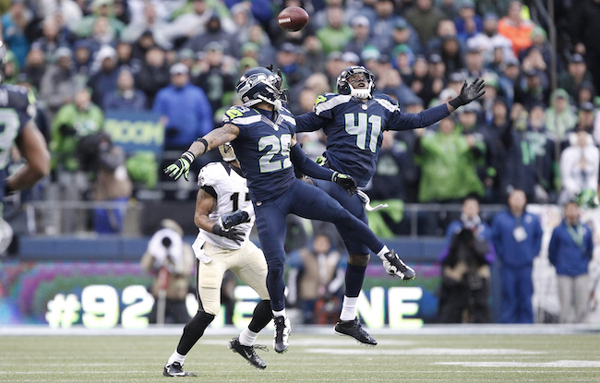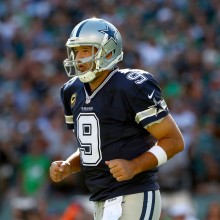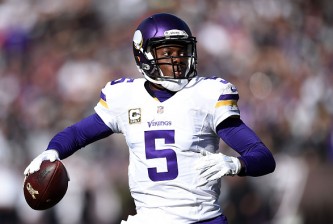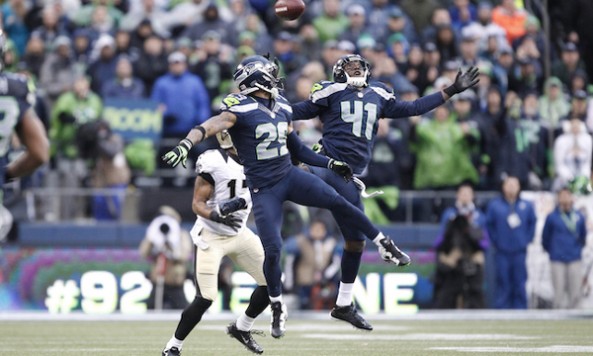
Football is continually evolving. From the first forward pass to the record-setting season from Peyton Manning in 2013, the NFL is in a perpetual state of constant change and motion. The T formation has given way to the spread, linemen weigh 100 pounds more than they did a few generations ago, and a superimposed yellow line now helps you know just when a team records a first down.
In recent years, the NFL has evolved into a passing league. The NFL set a new record once again in 2013 (as it seemingly does every year these days) with teams averaging 235.6 passing yards per game on 35.4 attempts. This is a big increase from just 10 years ago, when the average passing yards per game was a paltry 200.4. Remember when 3,000 passing yards was a great season? 21 quarterbacks (even Geno Smith and Chad Henne) crossed that threshold in 2013. 9 quarterbacks threw for 4,000 yards and 2 (Peyton Manning and Drew Brees) threw for 5,000 yards.
Before 2008 there was 1 5,000 yard passing season on record. Since 2008, there have been 7. Drew Brees himself has done it 4 times.
The single biggest reason why the NFL has developed into a passing league are rule changes designed to help quarterbacks and receivers. The biggest jumps in NFL passing numbers have come in the late 70s with the Mel Blount Rule and in 2004 when the NFL began enforcing more illegal contact and holding penalties after the infamous Colts-Patriots playoff game. With recent rule changes further protecting quarterbacks throwing those passes, the passing game has been given free reign to rule over the NFL.
But as physics has taught us… with every action, there is an equal and opposite reaction. In today's NFL, championships aren't won by stopping the run and running the football like we've been told for decades. They are won by passing the ball and, perhaps more significantly, defending the pass.
The Seattle Seahawks Legion of Boom secondary has proven to be the template on how to win games in the modern-day NFL — a speedy, physical, lockdown secondary that can shut down the game's most elite passing offenses. Nobody knows this better than the New Orleans Saints, which is why in they have chosen to sacrifice many key veterans to build a top-flight secondary to match.
Until yesterday, it hadn't been an encouraging offseason for the Saints. Pressed up against the salary cap as one of the teams with the least amount of dollars to spend, the Saints have cut several former starters to get under the cap. Veterans of the Saints Super Bowl XLIV defense Jonathan Vilma, Roman Harper, Jabari Greer, and Will Smith were all cut or not re-signed back in February. That saved the Saints $17 million in cap space. While those moves weren't a surprise, the news that the Saints planned to part ways with dynamo RB Darren Sproles and his $3.5 million dollar salary certainly was. (After planning to release him, now it appears the Saints will try to trade Sproles with a market building.) Free agent safety Malcolm Jenkins left for Philadelphia in the early hours of free agency. Starting offensive linemen Zach Strief and Brian de la Puente have not been re-signed and could depart. And that's not to mention the contract negotiations with all-world TE Jimmy Graham.
But the narrative of the Saints offseason quickly turned when the team shocked the football world and signed All Pro safety Jairus Byrd from the Buffalo Bills to the richest contract ever given to a safety — 6 years and $54 million dollars. Although money is unquestionably tight, the Saints can reasonably fit Byrd's salary into the team by restructuring existing contracts, something already done with RB Pierre Thomas.
Jairus Byrd was just one of several safeties to cash in on the first day of free agency. T.J. Ward (4yr/$23m), Donte Whitner (4yr/$28m), Antoine Bethea (4 yr/$24m), Mike Mitchell (5yr/$25m), Byrd (6yr/$54m), and Jenkins (3 yr/$16.5m) were all big name safeties to agree to big multi-year deals.
Given the success of the Seahawks building from the back forward, this should be no surprise.
The safety position, and the defensive secondary as a whole, has never been more important in the NFL. It's a natural evolution. To combat the growth and sophistication of passing offenses, teams are using more dollars to put towards the secondary to try to shut them down. Today's NFL is about finding athletes in the secondary who can cover ground and receivers. There's nobody better in the game at that than Seattle All-Pro safety Earl Thomas.

While cornerback Richard Sherman gets all the media hype, safeties Earl Thomas and Kam Chancellor are the backbone of the Legion of Boom. Their mix of size and speed is perfectly suited to today's NFL passing game. And no team knows that better than the Saints, who went 0-2 at Seattle against the league's best passing defense after seeing Drew Brees and Jimmy Graham largely shut down. Graham was particularly ineffective over the middle of the field versus Thomas and Chancellor.
Take a look at the numbers from this past season:
Brees vs Seahawks (2 games) – 55% completion percentage, 228 YPG, 6.08 YPA, 2 TDs, 0 INTs.
Brees vs Rest of NFL (16 games) – 69% completion percentage, 329 YPG, 7.95 YPA, 39 TDs, 14 INTs.
Graham vs Seahawks (2 games) – 4 catches on 15 targets (26.7% completion rate), 50 yards, 1 TD combined.
Graham vs Rest of NFL (16 games) – 86 catches on 139 targets (61.9% completion rate), 1,217 yards, 15 TDs.
The Seahawks not only shut down one of the game's great quarterbacks of all-time, they took away his #1 receiving target. So what is the response of the Saints and the other 30 teams in the NFL to Seattle's success? Imitate it, of course! Another truism of the NFL is that it's a copycat league.
Instead of pouring more money into the high-powered offense, instead of finding another target for Drew Brees, or plugging holes along the offensive line, New Orleans has instead added one of the game's premier ballhawking safeties. They've done this at the expense of keeping Sproles, who is 2 years removed from setting an NFL record for all-purpose yards.
Byrd's signing will only lead the vastly improved Saints defense to get better. After not being able to cover any receivers with multiple functioning limbs in 2012, the Saints pass defense became a strength in 2013 thanks to the additions of Keenan Lewis and Kenny Vaccaro. Under Rob Ryan, the Saints went from the #31 pass defense in 2012 to #2, just behind Seattle, a year ago. Teaming Jairus Byrd with Kenny Vaccaro and Rafael Bush (should he re-sign as a restricted free agent) should give the Saints one of the top safety groups in the league. It should also give New Orleans a defense that strongly resembles the one in Seattle which has been their Achilles' heel.
The Saints know first hand the importance of the secondary and the safety position. After building an identity for years under Sean Payton and Drew Brees as a passing team, they are now trying to construct a passing defense to match. That's the way to win in today's NFL. If the New Orleans Saints are choosing to build through their secondary and make it their top priority, it should be the surest sign of all that the NFL has taken another evolutionary step forward.























